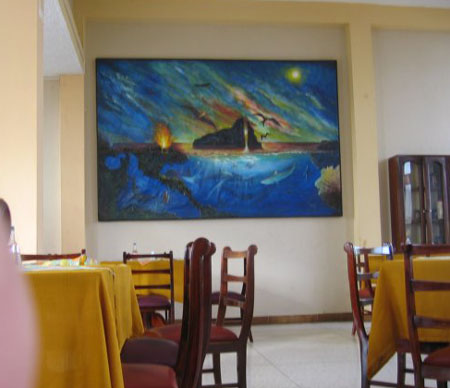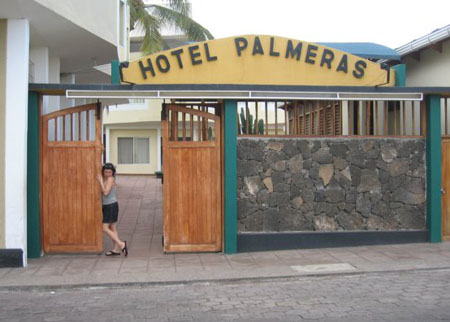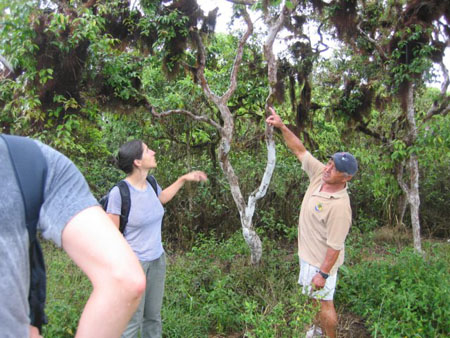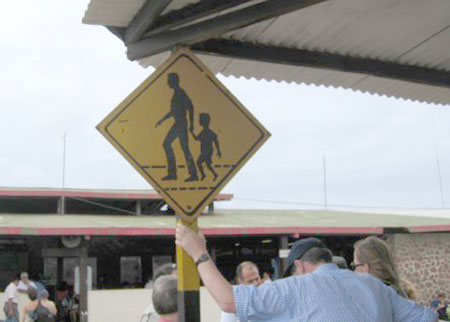|
|
|
Los Gemelos
Tuesday, February 1 2005
setting: Hotel Palmeras, Puerto Ayora, Santa Cruz Island, Galapagos, Ecuador
Wandering around our hotel before breakfast, we found our way up to a floor above the level of the second-story restaurant. Hidden away in a little room we found propaganda and flags used by a local labor union or leftist political party for their demonstrations.
Breakfast wasn't anywhere near as dismal as last night's dinner had been, if only because we ate very little. As usual in Ecuador, the coffee was Nescafé instant and the juice was some sort of artificial chemical concoction. Another thing that made this particular breakfast just a little more cheerful was that when we arrived the annoying German woman was just leaving. She had to leave early, she said, and this was the last we'd be seeing of her.
As we were packing up our luggage in anticipation of today's flight back to South America, I realized I'd lost my wide-brimmed hat, the only artifact I'd purchased in the Galapagos. It had cost me $10. Thinking back, I realized that I'd probably left it on the Golondrina when we went back for that final dreary lunch after checking into our Puerto Ayora hotel. I figured I'd have to just give up on it, since the Golondrina was probably off the coast of Española by now.
We headed into the touristy part of Puerto Ayora near the harbor with hopes of getting me a cup of real coffee. As we went down a tiny side street we could hear the familiar chorus of "Mariposa Traicionera," a popular song in Latin America introduced to us by Javier, our Spanish tutor. We could sing along and did so, if only so the the guy kicking back in his kitchen could see the unexpected sight of two gringos singing this decidedly ungringo tune.
The one restaurant with a hope of selling a cup of real coffee was closed, and the only places open were the kind with inevitable jars of Nescafé on every table. But while we were in the harbor we noticed that Golondrina had yet to leave. It was far outside of shouting range, so Gretchen got one of the other panga drivers to send it a message on the walkie talkie. But the message was ignored; perhaps the Golondrina uses a different set of frequencies. So then Gretchen tried to rent a water taxi. They only charge fifty cents for a ride out to a boat in the harbor, but we didn't have fifty cents in coins. All we had was a ten dollar bill, which to a water taxi driver might as well be $1000 bill. Finally, though, someone in a big powerful panga gave Gretchen a ride to the Golondrina for free. Sure enough, my hat was there, and Gretchen got a ride back to the dock from one of the Golondrina's crew.
Yesterday's tour guide, Bolivar, hadn't finished with us yet. Today, on the way to the Baltra airport, he would be taking us to Los Gamelos, an interesting pair of volcanic structures near the highest part of Santa Cruz Island.
Santa Cruz is a big island, and it takes awhile to get to the top of its spine. But the scenery is such that it doesn't seem to take very long at all. There's something inherently entertaining about watching climate change as you drive. Near Puerto Ayora conditions are fairly dry, but the closer one gets to the interior highlands, the lusher the vegetation becomes. As we approached the top, rain began to fall. It was our first experience with rain since getting to the Galapagos.
That rain became something of a problem as Bolivar gave us and the French couple a tour of Los Gamelos. Mind you, Gretchen and I had both brought rain coats (mostly for Quito and the Amazon), but Gretchen's leaked badly. As for me, I was still suffering from some sort of illness. My throat hurt and I'd developed a rather persistent cough, the kind that produces mouthfuls of salty unpleasantness that needs to be spit out. Being out in the rain wasn't exactly what the doctor had ordered.
As for Los Gamelos, that term translates into "The Twins." Each of the twins is a large (five acre) hole in the ground, surrounded on all sides by sheer hundred foot cliffs. The only creatures that can descend to the bottom are goats (introduced by Europeans). According to Bolivar, these holes weren't actually volcanic craters. Instead they were the result of massives subterranean volcanic gas pockets that at some point in prehistory had collapsed (silently, since no fundamentalist Christians were there to hear). Bolivar led us on a rambling walk through the forest in the rain in hopes of seeing, well, I forget. By the end Gretchen and I were soaked and somewhat miserable, though I think the French couple were still having fun despite their lack of raincoats. The trees near Los Gamelos are rich in epiphytes (picture Spanish moss), and Bolivar referred to them jokingly as "Galapagos Taliban" (because the epiphytes looked like beards). I might have left the Galapagos thinking Bolivar was clever had I not overheard his jokes being used by the guides leading other tours.
On the ride from the Santa Cruz heights down to the Baltra ferry, our small four-person Golondrina contingent was crowded together with the older Americans who'd been cruising in the lush comfort of our sister ship, the Fragata. Despite the fact that Santa Cruz island is scrubby desert from Los Gamelos all the way down to the northern beaches, I experienced no noticeable drying of my soaked clothing. Instead my cough worsened and soon exceeded the therapeutic power of my lozenges.
After the ferry ride to Baltra and the short bus ride to the airport, our bags were immediately subjected to inspection by Galapgos park authorities. I'd done a good job of concealing smuggled bits of coral, lava, and sea shells, but this proved unnecessary because the inspection (at least for my one piece of luggage, a computer bag) was so superficial.
I spread out our wet clothes atop the half-wall separating the airport waiting area from the outdoors and hoped the desert breezes, freshly squeazed of water after passing over the highlands of Santa Cruz, would sop up their moisture. My health continued to deteriorate, but I wasn't as bad off as the woman sitting on the bench behind me who suddenly collapsed and had to be carried away. I didn't notice until a burly woman seated next to me jumped up and announced, "We've got to give her more air!" And with that she tore the bench out from under me and flung it ten feet away. As the fallen woman was carried away a guy fanned her face with a piece of cardboard. This was an effort to give her even more air I suppose, but I had to wonder: if she was doing this badly at sea level, what would she be like once she got to Quito? Maybe she was only going as far as Guayaquil.
The airline for our flight back to Quito was TAME, pronounced "Tommy" (or, when you're angry at it, "Thomas!"). Everybody flies coach class, but conditions are reasonably luxurious and there's even a meal though it's only a two hour flight. But it being Ecuador, they'd never for a moment considered providing a vegetarian alternative. Lunch today was a tin of pasta and shredded, fatty pork. I was famished and it was the first pasta I'd seen in many days, so I devoured it without a moment's hesitation.
As before, we stopped in Guayaquil for a half hour as a crack team of vacuum cleaner people swept through. Then it was up and over the Andes and down a little into Quito, the second-highest national capitol in the world. The French couple from the Golondrina were still with us in the Quito airport, so we decided to share a cab to our destination, Old Town (at the southern end of the city). After a little negotiation, Gretchen managed to get the price of the cab fare for our four person contingent down from $8 to $6. It was a surprisingly long drive and there were plenty of second-hand diesel fumes to be inhaled along the way.
At some point the French guy asked Gretchen what she thought about the political situation in the United States and we explained everything from the stolen election(s) to the incredible power of our unique medieval irrationalist demographic. From his vantage point in France, the French guy was a little confused about the political strength of the various special interests in the United States. He knew about the Christian fundamentalists, but he was also under the impression that somehow the gays had a lot of power too. Gretchen quickly disabused him of this idea.
At some point during our cab ride I saw a little Citroen car wearing a flag-draped "Power of Pride" bumpersticker, the kind displayed only by the most self-deluded of post-9/11 American patriots. One of several ironies on display here was that there aren't actually any Citroen cars in the United States. Usually the "Power of Pride" sticker is only seen on huge SUVs. (By the way, I should mention that in the United States itself, patriotic magnets and stickers are largely East Coast phenomena. I see them all the time in liberal bastions such as Woodstock, New Paltz, and Manhattan in Blue State New York, though we only saw one the whole time we were on the West Coast this past Thanksgiving.)
Old Town looks like a well lived-in European city. The streets are alive with people trying to sell anything at all; I saw one woman with an armload of identical red-handled pliars. We bid adieu to our French companions and checked in to the place we'd be staying for the next two nights: the Hotel San Francisco de Quito. It's charming place centered around a courtyard and has been in continuous operation since the 1700s. In our first room I could throw open two layers of shudders and find myself looking out over the bustle of Sucre street. Immediately a guy down below tried to coax me down to sell me something. Eventually we had to change to a different room because this one was so loud.
Gretchen and I went for a walk around old town to take in the over-the-top splendor of Quito's churches and cathedrals. Inside one, we found that nearly every square inch of interior wall has been covered with a thin layer of gold, melted down from mounds of stolen Inca trinkets and now serving a new and improved (but nonetheless jealous) diety. I took a picture before being told I couldn't.
After some looking and asking, we managed to find Quito's Hare Krsna monastary. As always for such places, the monastary had an integrated restaurant, and it was the promise of flavorful vegetarian food that brought us here. When we arrived we were the only customers, and we could tell by the things they carried on the frequent trips to the pantry that they were making our rice and tofu stir fries from scratch. The food was delicious even if it was a little more Chinese-style than we would have preferred. Served with it was our first fresh-squeezed orange juice of the trip. As we ate we could hear the Hare Krsna people upstairs doing their Hare Krsna singing thing. One of the singers had an exceptionally bad singing voice, but that's never been a problem in for Hare Krsna. We noticed that this particular monastary was fairly lax about things like dress code and personal grooming. One of the guys there was wearing a Black Sabbath teeshirt. (I should point out that heavy metal and its even heavier relatives are very popular in Quito. I saw numerous teeshirts bearing the English names of obscure death metal bands like "Carrion Ingestion" and "Rotting Skull." [Okay, I made those up.] It's a lot easier being a teenager and wearing such a teeshirt to granny's house when granny can only read Spanish.)
After we'd eaten, we went upstairs and watched the Hare Krsna people sing for a little while. Everybody there seemed happy in a slightly cultish sort of way. As cults go, Hare Krsna is pretty inoffensive I suppose.
We were only charged $4.50 for our entire two person meal. Gretchen gave the Hare Krsna woman a $5 bill and told her to keep the change.
By now the sun had set and there was a bit of a chill in the thin Quito air. Despite the good nutritious meal, my health continued to falter. Walking home, I kept holding my breath to avoid inhaling the pollution of the passing buses. But the air was so thin that when I finally did inhale I did so with a certain desperation. We tried using streets we thought would be less likely routes for buses and that seemed to help a little. But I kept wondering to myself and out loud to Gretchen: how can people survive in this dreadful atmosphere?
Back at the hotel, I retreated into the shower to wash what I could of my sickness away. Happily the shower had hot water, but it wasn't quite hot enough, at least not at first. The fact that I began trembling violently as I stood beneath the shower head told me that my health had sunk to a new low.
I continued trembling for awhile after I'd dried off and disappeared beneath the bed covers. Now my body was weak and achey in a way that indicated the presence of fever. It was impossible to get comfortable, but somehow I fell asleep anyway.

The rebar whips and rubble of Puerto Ayora.

Gretchen holds a flag depicting a socialist hero.

Bad art in the Hotel Palmeras restaurant.

Gretchen poses at the entrance to the Hotel Palmeras. It perpetually smelled of electrical fire here.

One of Los Gamelos.

"Taliban" epiphytes at Los Gamelos. The little guy is Bolivar and the woman is Marie Jo, aka "Frenchie."

This sign at the Baltra airport seems to warn about the danger of child molestors leading little boys away.

A lavishly over-gilded cathedral ceiling in Old Town, Quito.
For linking purposes this article's URL is:
http://asecular.com/blog.php?050201 feedback
previous | next |







